|
|
|
|
|
|
A subsidiary signal, where provided, is always associated with (i.e. co-located with) a main signal (see Section 2). When cleared, the subsidiary signal authorises the main signal to be passed at 'danger' for a movement along the same running line to which the main signal applies, in circumstances when it is not appropriate to clear the main signal.
A subsidiary signal associated with a semaphore signal usually took the form of a miniature semaphore arm placed below the main stop arm. Most companies kept the subsidiary arm in the 'on' position while the main stop arm above it was cleared for a running movement [3.1]. On the Midland Railway and the North Eastern Railway, however, the interlocking was arranged such that the subsidiary arm had to be pulled 'off' first before the main stop arm could be cleared [3.2]. With either arrangement, drivers could disregard the subsidiary arm when the main stop arm above it was 'off'.
 |
 |
|
[3.1] Main Stop arm 'off' and Subsidiary arm 'on'. *
Area: All Areas Usage: High Status: Current |
[3.2] Main Stop and Subsidiary arms both 'off'. *
Area: Mid.R / NER Usage: High Status: Historical |
|---|
| * Note: | The illustrations above serve only to show the positions of the signal arms, which are described in Section 2 and the remainder of this section. |
Different categories of subsidiary signals were devised for specific purposes. A 'calling-on' signal authorises the driver to proceed forward cautiously and indicates that the line towards the next stop signal (or buffer stop where there is no main signal beyond) may be occupied. There were numerous different designs of calling-on signals [3.3 - 3.23]. In 1889, just five companies used calling-on signals; these were the L&YR, the LNWR, the LB&SCR, the LC&DR, and the North London Railway.
 |
 |
|
[3.3] Calling-on Signal ('on').
Area: LB&SCR Usage: Unknown Status: Historical |
[3.4] Calling-on Signal ('off').
Area: LB&SCR Usage: Unknown Status: Historical |
|---|---|
 |
 |
|
[3.5] Calling-on Signal ('on').
Area: SE&CR Usage: Unknown Status: Historical |
[3.6] Calling-on Signal ('off').
Area: SE&CR Usage: Unknown Status: Historical |
 |
 |
|
[3.7] Calling-on Signal ('on').
Area: L&SWR Usage: Unknown Status: Historical |
[3.8] Calling-on Signal ('off').
Area: L&SWR Usage: Unknown Status: Historical |
 |
 |
|
[3.9] Calling-on Signal ('on').
Area: GNR Usage: Unknown Status: Historical |
[3.10] Calling-on Signal ('off').
Area: GNR Usage: Unknown Status: Historical |
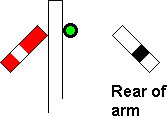 |
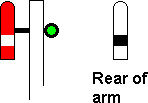 |
|
[3.11] Calling-on Signal ('on').
Area: G&SWR Usage: Unknown Status: Historical |
[3.12] Calling-on Signal ('off').
Area: G&SWR Usage: Unknown Status: Historical |
 |
 |
|
[3.13] Calling-on Signal ('on').
Area: NBR / NER Usage: Unknown Status: Historical |
[3.14] Calling-on Signal ('off').
Area: NBR / NER Usage: Unknown Status: Historical |
 |
 |
|
[3.15] Draw-ahead Signal ('on').
Area: GER Usage: Unknown Status: Historical |
[3.16] Draw-ahead Signal ('off').
Area: GER Usage: Unknown Status: Historical |
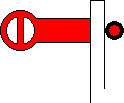 |
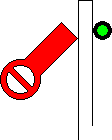 |
|
[3.17] Draw-ahead Signal ('on').
Area: GER Usage: Unknown Status: Historical |
[3.18] Draw-ahead Signal ('off').
Area: GER Usage: Unknown Status: Historical |
 |
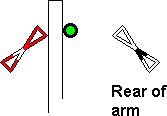 |
|
[3.19] Calling-on Signal ('on').
Area: GWR Usage: Unknown Status: Historical |
[3.20] Calling-on Signal ('off').
Area: GWR Usage: Unknown Status: Historical |
 |
 |
 |
|
[3.21] Calling-on Signal ('on').
Area: Mid.R / M&GN Usage: Unknown Status: Historical |
[3.22] Calling-on Signal ('off').
Area: Mid.R Usage: Unknown Status: Historical |
[3.23] Calling-on Signal ('off').
Area: M&GN Usage: Unknown Status: Historical |
|---|
In 1893, the North London Railway decided to install a supplementary type of distant signal at certain locations. Known as a 'calling-on distant' or 'station distant', this signal was similar in appearance to an ordinary calling-on signal, but its arm was fishtailed [3.24] and it was placed below a main distant arm. When the calling-on distant was cleared [3.25], it indicated that the home signal ahead was 'off' but the starting signal beyond it was 'on'. In accordance with North London Railway practice, rings were fitted to the arms of signals applying to the 'No. 1' lines [3.26 & 3.27]. The first calling-on distant was installed in November 1893 on the Up line at Dalston Junction No. 1, and the last of these signals was abolished in 1940.
 |
 |
|
[3.24] Calling-on Distant Signal ('on').
Area: NLR Usage: Low Status: Historical |
[3.25] Calling-on Distant Signal ('off').
Area: NLR Usage: Low Status: Historical |
|---|---|
 |
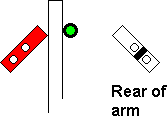 |
|
[3.26] Ringed Calling-on Distant Signal ('on').
Area: NLR Usage: Low Status: Historical |
[3.27] Ringed Calling-on Distant Signal ('off').
Area: NLR Usage: Low Status: Historical |
|
|